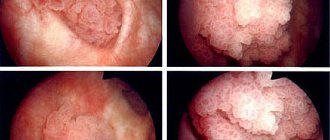Definition of urethral caruncle
Urethral caruncles are benign lesions of the urethra that most often occur in postmenopausal women, although rare cases have been reported in girls. However, in 2012, Karthikeyan and colleagues reported a single case of urethral caruncle in a man.
Urethral caruncle is often mistakenly called urethral polyp.
In 1926, Ferrier eloquently described the macroscopic appearance of the urethral caruncle as a vascular tumor, the size of a pinhead to a raspberry, on a broad base, located almost always along the posterior wall of the female urethral canal; it may be congested, tense, bleed easily, and sensitive to any touch.
Urethral caruncles, which often arise from the posterior lip of the urethra, appear as fleshy growths of the mucous membrane of the distal urethra. They are usually small, but can grow to 1 cm or more in diameter.
A urethral polyp or caruncle may resemble urethral prolapse in appearance, which is a circumferential formation, while caruncles are focal.
Differential diagnosis of a polyp or urethral caruncle is carried out with:
- Urethral diverticulum
- Urethral prolapse
- Urethral cancer
- Abscesses of the periurethral glands
- Condylomas acuminata
- Tuberculosis of the urethra
- Paraurethral cyst (Skeene gland cysts)
Unfortunately, the list of differential diagnoses is long, diff. Diagnosis is carried out with many pathologies that have very similar manifestations. Kaneko et al. It is believed that 1.6% of removed polyps contain carcinoma cells, and according to Conces et al. the detection rate of carcinoma was 12%, thus, gynecologists, urologists, and urogynecologists should first of all carry out a differential diagnosis with malignant tumors of the urethra.
Symptoms
Polyps in men and women initially develop in a latent form, not making themselves known for quite a long time.
The first symptoms appear:
- with significant growth of the polyp, reaching a large size (a large polyp blocks the urinary tract, causing disturbances in the urinary process);
- with mechanical damage (when lifting heavy weights, the polyp can tear off from the wall of the organ).
In these cases, patients may observe:
- signs of hematuria (urine becomes pink and sometimes red);
- urinary retention;
- “sluggish” urine output;
- pain;
- heaviness in the groin;
- fatigue;
- temperature increase.
Causes of formation of urethral polyps
Hormonal: It is believed that urethral polyps in women occur due to a decrease in estrogenization of the smooth muscles of the urethra, which leads to atrophy of the urethral mucosa and contributes to mucosal prolapse. In turn, chronic irritation (maceration) of the descended segment of the mucosa leads to inflammation, and granulation promotes proliferation.
Inflammatory: the theory is that the caruncles of the female urethra are the result of an inflammatory process, after suffering from urethritis and other inflammatory processes.
Below is a table of differential diagnosis of urethral caruncle with other possible diseases.
Differential diagnosis of urethral caruncles
| Education | Description | |
| Benign processes | Urethral caruncle | A small prolapse of the urethral mucosa, usually originating from the posterior wall. The exophytic part is represented by edematous, sometimes loose mucosa, has a red or purplish-red color, and due to thrombosis it can become purple or black. Focality is characteristic. |
| Prolapse or prolapse of the urethral mucosa | The protrusion of the mucous membrane covers the entire circumference of the meatus, has a smooth surface, and the reddish color of the mucous membrane. | |
| Urethral polyp | A benign, pedunculated lesion that protrudes from the meatus is more common in children | |
| Paraurethral cyst (Skenes gland cyst) | It appears as a round, shiny protrusion containing fluid or pus. The tabernacle glands are embryological vestiges of the male prostate. Multiple ducts form a network that surrounds the female urethra, mainly along the posterior and lateral walls. The number of ducts varies from 6 to 31. They are usually concentrated and empty into the distal (lower) third of the female urethra. The secretion of the tabernacle glands acts as a protective barrier for the urethra during coitus. | |
| Urethral diverticulum | A protrusion in the projection of the urethra, which communicates with the urethra. Obstruction of the excretory ducts of the paraurethral glands leads to their inflammation and abscess formation. Breakthrough of an abscess into the lumen of the urethra as a result of trauma (coitus, vaginal birth) or tissue necrosis leads to the formation of a urethral diverticulum. | |
| Bartholin gland cyst | Bartholin's glands are located at the entrance to the vagina in the thickness of the labia majora, excretory ducts open on the inner surface of the labia minora. A cyst is a protrusion in the labia area containing fluid or pus inside. | |
| Condyloma acuminata | Wart-like growths around the urethra, the color of the surrounding tissues, the cause of the occurrence is the presence of the HPV virus. | |
| Malignant lesions of the urethra | Urethral carcinoma | It appears to be a loose, ulcerated tissue formation emanating from the lumen of the urethra. May present as a hard tissue mass accompanied by lymphadenopathy. Primary urethral cancer is very rare. Risk factors are chronic inflammatory processes of various etiologies. The most common primary tumor is squamous cell carcinoma, originating from the anterior urethra, about 75%; the rest are transitional cell carcinoma, adenocarcinoma, sarcoma or melanoma arising from the posterior urethra. |
| Bladder cancer | A bladder tumor can push through the urethra and has a papillary type of growth. | |
| Urethral leiomyoma | The nodular form of the tumor, emanating from the urethra, is formed from periurethral smooth muscle. | |
| Vulvar cancer | An ulcerated, friable lesion of the vulva that may be intimately adherent to the urethra. |
Complications of the disease
One of the main complications of the disease is chronic or acute urinary retention. In the first case, the condition can progress, significantly reducing the patient's quality of life and leading to the development of hydronephrosis and chronic renal failure. Acute urinary retention is a condition requiring immediate medical attention.
Another complication of the disease should be the development of a malignant tumor against the background of an existing formation. Malignancy of polyps of the urethra or bladder is observed less frequently compared to the gallbladder, intestines or stomach, but this option is not excluded. Therefore, if the tumor is large or begins to grow, it is still better to remove it.
If we talk about pedunculated polyps, they can not only close the lumen of the urethra and be complicated by acute urinary retention, but also become necrotic due to torsion of the pedicle and cessation of blood supply.
Another dangerous complication is the development of infectious processes. The presence of neoplasms in the cavity of the urethra improves conditions for the proliferation of various pathogenic microflora. As a result, urethritis, cystitis and even pyelonephritis develop, which over time can lead to renal failure, and then to the death of the patient without qualified medical care.
Constant hematuria is also a rather dangerous condition for the human body. With polyps in the urethra, the discharge of blood in the urine may be invisible to the human eye, but still constant. As a result, anemia will develop and the patient’s general well-being will decrease. Also, a blood clot may form in the lumen of the urethra. This will lead to tamponade of the cavity, and ultimately acute urinary retention will form. Without medical assistance provided as soon as possible. It will be impossible to solve this problem.
Clinical manifestations of caruncle or urethral polyp
Caruncles are often asymptomatic but may be accompanied by hematuria, spotting, pain, dysuria, or obstructive symptoms.
Most urethral polyps are asymptomatic and are discovered incidentally during examination. However, there may be pain in the urethra, pain during urination, difficulty urinating, in rare cases, urinary retention, bleeding of the exophytic part of the formation, or, most often, patients notice blood on their underwear.
On examination, caruncles appear as a pink or reddish exophytic formation emanating from the urethral canal (see figure below); in rare cases, they turn purple or black due to thrombosis. Some caruncles or polyps may resemble urethral cancer in appearance.
Diagnostic methods
In most cases, urethral caruncle is detected during a routine gynecological examination.
Cystoscopy may be performed either on an outpatient basis or during excision of a urethral polyp to rule out more serious pathologies or when the cause of hematuria is unclear. Cystoscopy is not performed when the diagnosis is obvious, there is no hematuria and surgery is not planned. A general urine test with sediment microscopy and urethral culture for microflora are necessary to exclude urinary tract infection in cases of dysuria, urethral discomfort or urethral pain. Make an appointment
Make an appointment with a gynecologist by calling 8(812)952-99-95 or filling out the online form - the administrator will contact you to confirm your appointment
guarantees complete confidentiality
Prognosis for polyps
Urethral polyp is a disease in most cases with a favorable prognosis. The pathology, if detected in a timely manner, is easily amenable to surgical treatment, after which the patient can return to a full life. The main task of both the patient and the doctor is to prevent the development of complications, which pose a much greater threat to life and health than the formations themselves.
To prevent the development of complications, it is enough to monitor the tumors and promptly carry out surgery to remove them to the maximum extent recommended by doctors, and then follow medical recommendations to prevent relapse.
- Urology: textbook / B.K. Komyakov.
- Urology: textbook / [S.Kh. Al-Shukri, V.N. Tkachuk]
- Method for differential diagnosis of female urethral polyps
- Russian patent 2014 according to IPC A61B8/06
- RU 2 527 173 C1
- AUTHORS: Neimark Alexander Izrailevich; Yakovlev Andrey Vladimirovich, Kondratyeva Yulia Sergeevna Nepomnyashchikh Lev Moiseevich
Treatment of urethral polyp or urethral caruncle in women
Most urethral caruncles can be treated conservatively with estrogen and anti-inflammatory drugs.
Surgery may be indicated for patients with severe symptoms, lack of response to therapy, and patients with an uncertain diagnosis. Possible indications for surgical removal of the urethral mass followed by histological examination:
- Compaction of formation
- Lack of effect from conservative therapy
- Atypical appearance
- Fast growth
- Intense bleeding
- Complications that arise after excision of a urethral caruncle include: recurrence of formation, narrowing of the lumen (stenosis or stricture of the urethra).
- Observation and prognosis of the disease
If the urethral caruncle is confirmed, then the prognosis is favorable. There are no specific recommendations in the literature regarding surveillance, however, given their benign nature, if more serious pathology has been ruled out and symptoms have resolved, then it is read that no specific surveillance is required.








